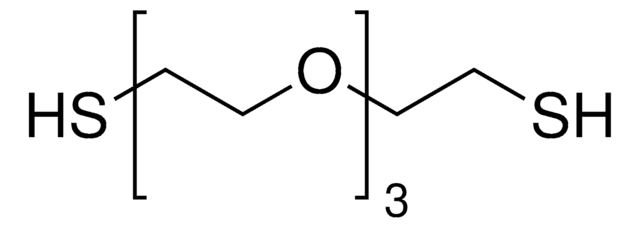673110
Triethylene glycol mono-11-mercaptoundecyl ether
95%
Synonym(s):
(11-Mercaptoundecyl)tri(ethylene glycol)
About This Item
Recommended Products
Assay
95%
refractive index
n20/D 1.476
density
0.995 g/mL at 25 °C
storage temp.
−20°C
SMILES string
OCCOCCOCCOCCCCCCCCCCCS
InChI
1S/C17H36O4S/c18-10-12-20-14-16-21-15-13-19-11-8-6-4-2-1-3-5-7-9-17-22/h18,22H,1-17H2
InChI key
FASSFROSROBIBE-UHFFFAOYSA-N
General description
Application
Storage Class Code
10 - Combustible liquids
WGK
WGK 3
Flash Point(F)
>230.0 °F
Flash Point(C)
> 110 °C
Personal Protective Equipment
Certificates of Analysis (COA)
Search for Certificates of Analysis (COA) by entering the products Lot/Batch Number. Lot and Batch Numbers can be found on a product’s label following the words ‘Lot’ or ‘Batch’.
Already Own This Product?
Find documentation for the products that you have recently purchased in the Document Library.
Customers Also Viewed
Articles
Recent research highlights tunable properties of inorganic nanoparticles, driving interest in optoelectronics.
Self-assembled monolayers (SAMs) have diverse applications; article compares benefits of alkylthiolates on gold SAM systems.
Our team of scientists has experience in all areas of research including Life Science, Material Science, Chemical Synthesis, Chromatography, Analytical and many others.
Contact Technical Service![2-{2-[2-(2-Mercaptoethoxy)ethoxy]ethoxy}ethanol 97%](/deepweb/assets/sigmaaldrich/product/structures/130/969/7d2ec2b4-e0f1-4836-aeb2-139994173612/640/7d2ec2b4-e0f1-4836-aeb2-139994173612.png)












